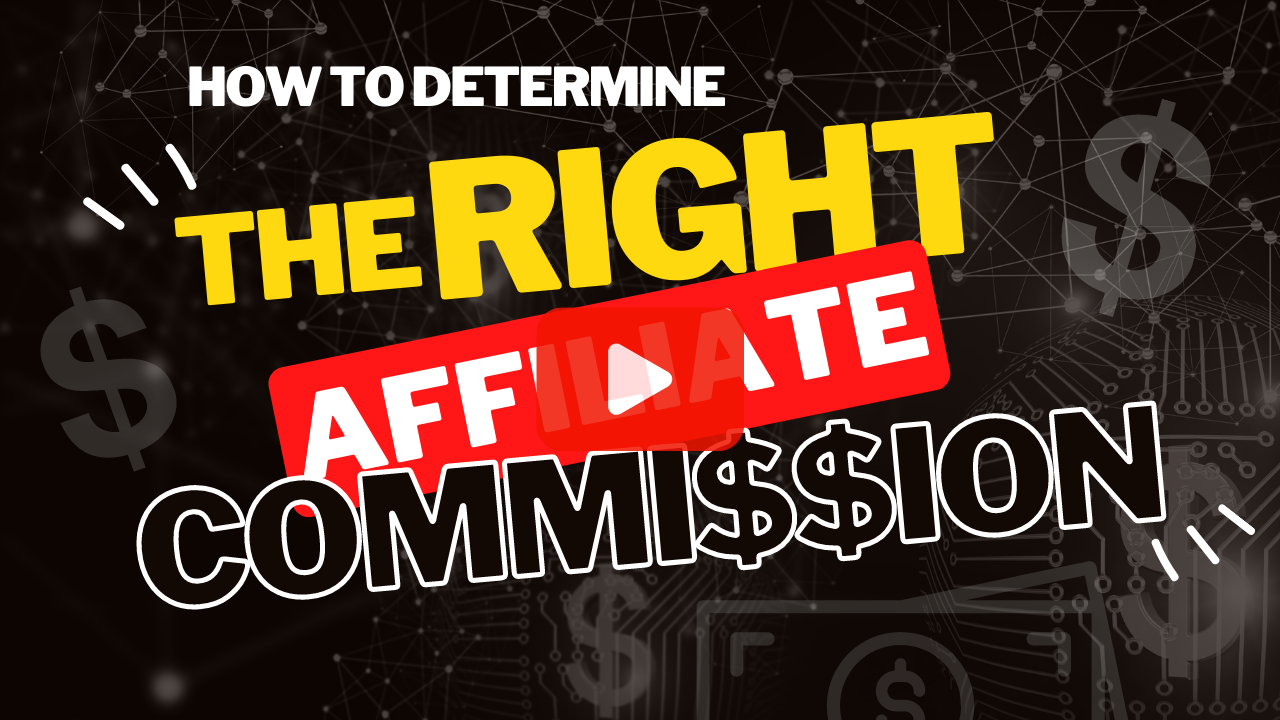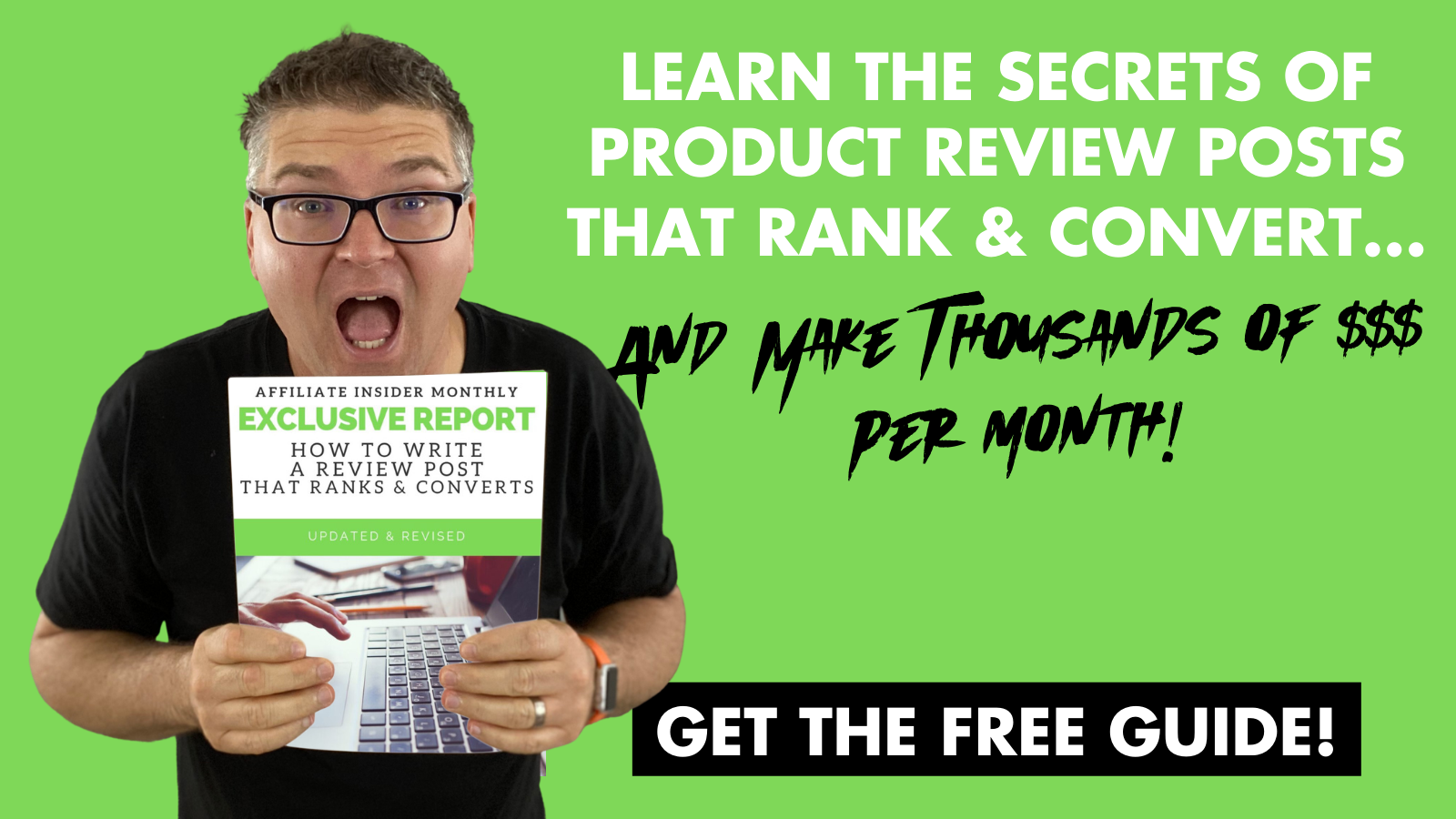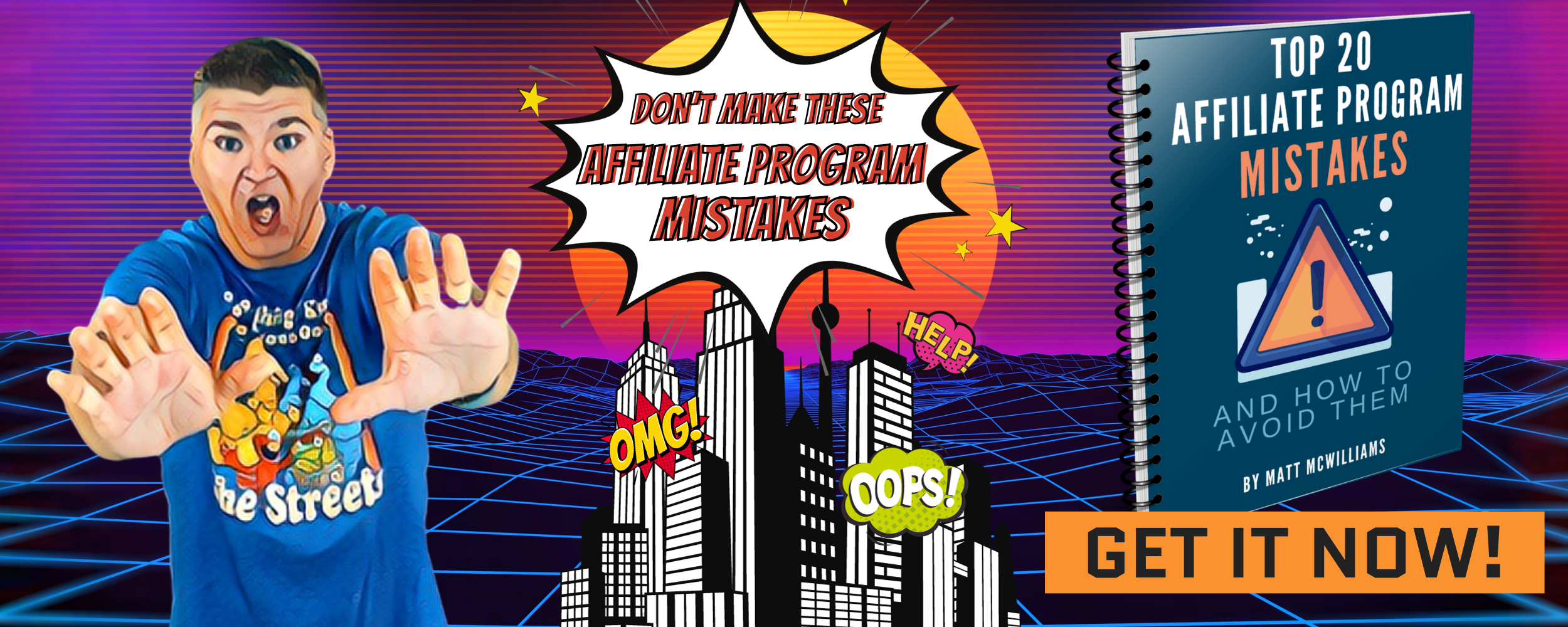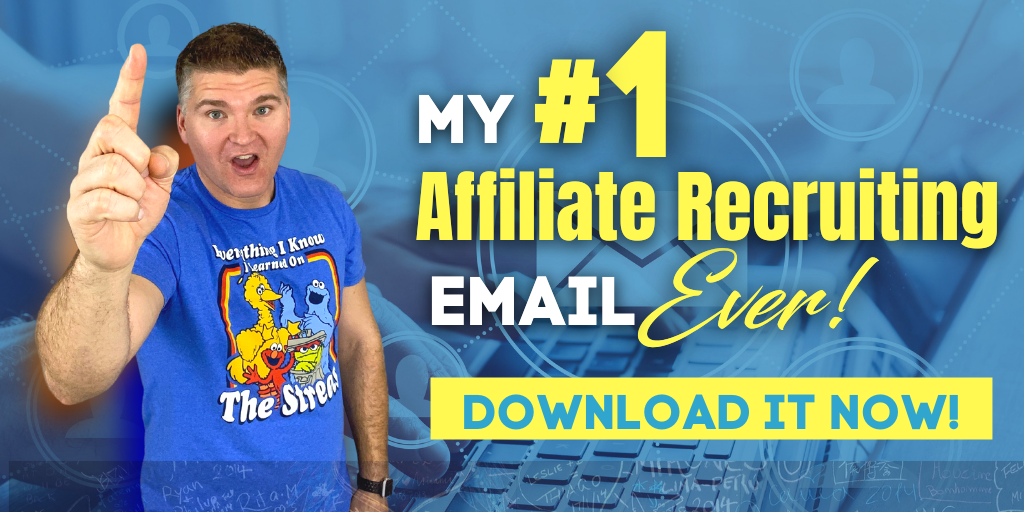Try The Passive Income System

Do affiliate bonus packages still work in 2024? Today I share what the latest research reveals about affiliate bonus packages. You’ll learn the truth behind common myths surrounding bonus packages and learn the secrets to crafting irresistible offers that drive results. Affiliates and affiliate managers, this episode could be worth millions, so listen up!
Click Here for The Written Transcript of This Episode
Not sure how much to pay your affiliates? Watch my free video tutorial on YouTube that walks you through step-by-step.


Links Mentioned in this Episode
Your Affiliate Launch Coach
How I Built a $1 Million a Month Affiliate Program In Only Two Years Without Any Connections or Credentials
TEXT ME +1 260-217-4619
Don’t Miss An Episode – Subscribe Below
Previous Episodes of The Affiliate Guy
How to Give Your Affiliates What They Need to Succeed
How to Build an Army of Loyal Affiliates
Got a Low-Priced Product? Here’s How to Run an Affiliate Program
How Top Affiliates are Closing Sales in 2024
How to Find Affiliates Using Affiliate Program Leaderboards
If Donald Trump Ran an Affiliate Program
What the Latest Research Says About Affiliate Bonus Packages
Do affiliate bonus packages still work in 2024? Today I share what the latest research reveals about affiliate bonus packages.
You’ll learn some of the common myths surrounding these bonus packages, and you’ll learn the secrets to crafting irresistible offers that drive results. Affiliates and affiliate managers this episode could be worth millions, so listen up.
So we’ve all seen these elaborate, some might say over the top bonus packages that come with affiliate offers, right?
You’ll buy this course through my link and you’ll get $47,942 in bonuses. Right? But do they actually work?
Almost a decade ago, back in 2015 or 16, I released the results of a study that I had done, the first of its kind that I know of that proved that, yes, they do work. Affiliate bonus packages worked to increase sales, but there were some pitfalls to avoid some best practices that we found. So about every four years I revisit this, and here we are, 2024. Do they still work?
Are they going to continue to work for the next decade or so? You know, like I said, every few years I do this study and I do other topics as well. If you listen, you know that recently I released the findings of 2023,24 a And I do these studies periodically across a few different things just to quantitatively, not just qualitatively prove what’s working in affiliate marketing, what is working to increase sales. And affiliate bonus packages are one of those things.
So this episode is not only for affiliates, but for you affiliate managers to share with your affiliates. Now let’s start with what I mean by, you know, these bonus packages. And how do bonus packages work? You may have used this strategy. You may have seen it.
You’ve definitely seen it done, right? You offer an exclusive bonus if people buy a product through your link. Now I’m going to go into more detail about what makes a good bonus package in this episode.
But for now, what you need to know is that an effective bonus is one that takes an on the fence buyer and turns them into an actual buyer. I always picture just, it takes somebody who’s literally got one leg on either side of the fence and they can’t decide, should I buy this thing or not.
And then you present a bonus package that makes this an irresistible offer, and they say yes. In other words, it’s something attractive enough to cause a person to take action. That’s what we want people to do in affiliate promos. Now, as I mentioned earlier, I did my first study on this back in 2016, and it started with a personal test of mine.
This is how I know that affiliate bonus packages work, because I not only surveyed others, but I tested it myself. And bonuses, one, having bonuses increased sales by 240%. Before that, the reason I actually did this study, my hypothesis was that they don’t increase sales.
I actually went into the study believing that bonuses were a waste of time and I only offered them. And I did a couple of affiliate promos. You know, this is early on in my where I started doing more affiliate marketing. You know, I’d been an affiliate manager for over a decade at that point, but I started doing affiliate marketing and I’m like, well, everybody else is offering bonuses, let me test it or let me do it right.
Want to learn how to make passive affiliate income from product review posts? Get my free guide on how to write a review post that ranks and converts and learn how we bring in more than $10,000 every single month in passive affiliate income! Get it here!

I never took the time to actually ask, do they work? And so I went into it with the hypothesis that they either did not lift sales or they lifted it so marginally that it wasn’t worth the hassle. And that’s what I was hoping to find. The scientific method, if you learn that in middle school, high school, you have a hypothesis, then you test it and you either prove or disprove the hypothesis.
Well, I disprove the hypothesis. I went into it hoping that they would not work so that I didn’t have to put in the effort to create bonuses. I’m only going to increase sales 5%, 10%, no percent. So why would I even bother?
So here’s what I found. Back in 2016, the first promo that I did was a $200 product. Having the bonuses, I made $9,000. Non bonuses, I made $4,500, almost exactly half, just a couple of dollars off from being exactly half. So I made twice as much money with the bonus. That was on a $200 product.
On a $1000 product, the difference was huge. It was 13,000 versus $2,000 overall between those two promos. 22,000 versus $6,500 240% increase with a bonus. And then I found over the course of subsequent promos, subjectively, I would have people tell me that they purchased through my link specifically for my bonuses. So I knew they were making a difference.
Again, that’s a subjective justification for bonuses. Now, since that first test back in 2016, I have noticed objectively that bonus packages work too. I’m going to share how the numbers line up in terms of commissions earned per click sent to an offer based on five random promotions without a bonus and five with a bonus.
This is across numerous niches, different size list. I’m trying to think of the five different affiliates. There were two females, three males. Two of them were in similar niches. The other three were in completely different niches.
You know, these are, again, different size audiences, different experience levels, even different types of audience, different price points. I mean, everything you could think of, there is a total variety here.
The promotions with no bonuses earned the affiliate an average of $0.37 per click. The promotions with a bonus earned them an average of $18. And a crazy thing about the bonuses is they’re not even that elaborate.
I remember one of them was simply that I would join them, that one of them was me, I would join their accountability group. Another was that they would get a 15 minutes coaching call.
Not extravagant, right? And I’m going to share in a little bit why bonuses don’t have to be extra. In fact, they shouldn’t be extravagant. Other affiliates, as we. That reported to me in a little bit less scientific method, right.
Just what they were reporting to me found that having bonuses increased sales little as 110% to as high as 320%, with the average falling right near what I found. I found 240% the average among these affiliates was 225%. So that’s what I found over time. What about now, though?
What about 2024? Well, here’s what the research found. Bonus packages are slightly more effective, marginally almost exactly the same as they were ten years ago, eight years ago. But there are some important caveats that I’ll cover, okay?
There are some aspects of bonuses that are relevant in 2024 that weren’t relevant even four years ago. And the first important caveat, this has been true for a while, is that bonuses don’t have to be and shouldn’t be extravagant, as I mentioned.
Now, if you look back at what’s worked, whether it be with me, with other affiliates that I’ve talked to, studied, people that were in the groups that I studied, the bonuses were super simple. I created a formula about eight years ago for coming up with bonuses, and I just really made it easy on myself. And so for me, more recently, like, none of them are that particularly complicated.
They’re not difficult to put together. And so you’ve probably seen these extravagant bonus packages, right? And you’re like, I could never do that. I cannot put like, that’s a $45,000 bonus package. You don’t have to do that.
You don’t have to do that. In fact, the effort you spend might literally be worth almost nothing. I didn’t say earlier that like putting dealer bonuses as my hypothesis suggested is pointless.
But there is a point of diminishing returns and ill talk about that in a little bit where there’s a point where adding more bonuses does not add sales. You see this increase, that adding a little bonus doesn’t actually
increase sales that much. And then adding a little bit more, all of a sudden you start to see it go up and then when you get this sweet spot it goes up even more and then it levels off.
It just completely levels off. And so crossing that point, it’s kind of like I was listening to a book the other day about running and I’m training for a half marathon and I was listening to this book and you know, for me, running a half marathon at my target rate, my age, my goal is to finish top five in my age group in this particular one.
And so I know my target time. If you’re curious, it’s an hour 44 minutes and 48 seconds. That is my target time. It’s based on who’s entered in the past. I would finish in the top five every year for the past decade.
So that’s my target time. If I happen to run that and finish in 6th place, so be it. I mean, it is what it is.
So, you know, it’s literally 1 second under eight minute miles. And I was listening to this book and it talked about how in your weekly training for me at that distance, I want to be targeting 42 to 48 miles a week.
And that running 52 will have no increase in anything. It will not make me faster, it will not make the 13. 1 mile easier.
Like it will have no increase past that certain point. And so again, like getting up to that point, obviously if I’m going to run 13.
1 mile at my sub eight minute miles, I need to be running at least 20. I’m not going to see much improvement going from zero to 5
miles a week. You know, I’m going to see very, very little improvement there. I’m going to see a pretty good improvement from 5 to 20.
I’m going to see a lot of improvement from 5 to like 35 and I’m gonna see a little bit more really fine tuning up until about 45 to 48. Then after that I’m not gonna see any improvement.
Same is true with these bonuses. And so what I found in my research over the past decade is that back in the mid 2010s, those extravagant bonuses with lots of extra courses, you’re going to buy this one course from this one person, but you’re going to get this course and this course and this course and this course and this course.
Having that $30,000 bonus package worked today, not so much. And I’m going to share some of those important findings that I found that work more recently. It’s just not working as well to put together those big bonus packages.
People don’t, just don’t want the information as much. And so I’m going to talk about that in a little bit. But first, I want to share some of the basics of putting together a bonus package. And I’ve shared these in prior episode, I don’t remember when, but it’s been a long time. It was probably over four years ago.
I shared these basics, but I’m going to cover them again just in case you missed them. It’s a three part formula when we promote affiliate offers that we use in our company, but we also share with our affiliate partners for our clients when we’re running their affiliate launches and their affiliate promos.
The first one, first key, use what you have.
Use what you have. Put together bonuses that you already have. If you look back to that very first promo where I ran that test, I created a special bonus just for that affiliate launch, I created a bonus, but I’ve used it over and over again since then.
Robby Miles, who’s our operations manager, he calls this stacking the Lego bricks. The way he looks at it is our products, our mini courses, our ebooks, our templates, our swipe files, our cheat sheets, our coaching, all of these things, these are Lego bricks within the company. And so to him, creating the right bonus stack is just all about combining those bricks into something appealing.
So we have about 30 to 40 different Lego bricks, and we’ll be promoting something and we’ll bring in five of them for this particular offer because those are the five best Lego bricks. If I were to add a 6th, it would dilute the offer.
We’ll talk about that later. And I’ve touched on it a little bit before. It would make the offer worse because that 6th thing is not perfectly relevant to this offer. And so what’s the right amount? It’s everything that should be in it and nothing more. You know, if anything above, beyond what needs to be in it, is too much.
The second key, second principle that I’ve shared before is create nothing if at all possible.
And so I found that a great way to offer a really amazing bonus package is to go through the course with them or to do some bonus coaching calls or something like that. We’ll do four bonus coaching calls or I mentioned earlier, I joined their accountability group. I promoted my friend Alan Thomas’s weight loss offer. And one of the things is that each person, they create an accountability group.
And I said I will be in your accountability group. If you join Alan’s program through my link, I will be in your accountability group. And that’s valuable to people because I mean I’ve been in a couple for over two years now and I’m in there cheering them on. Not every day, but it takes me, you know, 10 15 seconds a week to cheer them on.
And people love that. And essentially like the group coaching, that’s small group coaching. They can ask me questions and stuff. I’m, I’m going to be with them for 4 hours over the course of eight weeks. But I’m not creating anything on the front end. And I just, I mean frankly all I have to do is show up and answer questions. That’s super easy.
Don’t make the same mistakes I’ve made with my affiliate programs. Learn my top 20 affiliate program mistakes…and how to avoid them!

The third key is to aim for an equal value or higher.
Equal value or higher. So in other words, if you’re promoting something that’s $1,000, your bonuses should be $1000 to $4,000. If you’re promoting something that’s $2,000 it should be about $2000 to $8,000. If you go higher than this 8000, this is what we’ve begun to see and I’ll cover more later. It starts to seem ridiculous.
Destroys the effectiveness of offering a bonus. And the only exception to this that we found is if you do offer a single bonus that happens to be worth five, six, seven times the value of the product, that’s okay. The issue is when you’re stacking like 10, 12, 13 bonuses and the value is $20,000 on a $2,000 product.
The fourth thing is it needs to fit the offer.
Your bonus has to fit the offer. It cannot be this random thing. Like I mentioned Alan’s thing earlier. It would be ridiculous if I said, hey, join Alan’s weight loss program and get my free course on copywriting.
Get my course on copywriting that normally sells for $1,000 for free. Like what? That’s ridiculous. Now if I offered my bonus about overcoming your limiting self beliefs, that makes sense. That’s a bonus that fits weight loss, right?
And the two best ways to fit an offer to complement and what we call compliment and close the gaps. Compliment is if you’re promoting a course, for example, lets say it is about copywriting, then good bonus that complements a copywriting course is the sales page tactics sales page layout software tool that allows you to create landing pages.
That makes sense. With a copywriting program. Closing the gap means that the course is missing something that’s specific to your audience or it doesn’t go in depth.
I mentioned years ago, I worked with a company, we sold a course on guitar and we had an affiliate that had a Blues Guitar course. And so when they purchased our course right through him, he gave them his blues guitar mini course. Not his full blues guitar course, but his Blues Guitar mini course as a bonus.
Why? Cause we only had one lesson, an hour long lesson on Blues Guitar. He had a two hour mini course that took it to the next level.
So if you teach social media marketing, for example, and then you’ve got like a book that’s all about social media headlines to go viral, offer something like that. That’s a really good example.
All right, the last key here that I want to share, the key to effective bonuses, good bonuses that actually work is this.
You gotta sell your bonuses.
You gotta sell your bonuses. Like seriously play them up big time. Talk about them in every email. Yeah, I mentioned a few episodes ago, I talked about how top affiliates are closing sales. They are using these bonuses.
And when we studied what the top converting affiliates were doing, we found that they were mentioning their bonuses in every single email. They mentioned them.
Every single email they mentioned them. Every single cart close email. They had dedicated emails, at least one about all about their bonuses.
Most of them recorded a video explaining their bonuses. Most of them created a special page for their bonuses. All of these things to really play up and sell their bonuses.
If a tree falls in the forest and no one’s around to hear, does it make you sound the same? Is true with your bonus. You have the best bonus package in the world and if you don’t sell it, it doesn’t work. And offering a great bonus package is one of the five things that I found that all the top converting affiliates did consistently.
On that note, really getting clear about the benefits of each bonus that’s part of selling. How does each bonus add value to the main product? Why is it a must have?
And this helps in justifying that overall package, right? It really helps people make a decision. So don’t just say, hey, you’re going to get this, this, this and this.
Well, okay, no, tell them what the benefit is so in that blues guitar example, it’s like, hey, go buy, learn and master guitar. You’re going to learn all about guitar and you’re going to get my mini course on blues guitar.
So when you come out of this experience, you’ll have a bass in guitar, but you’ll also have that next step, little bit of extra on blues guitar, which of course, to Dan Danley, the maker of the Blues guitar course, is like, well, that sets him up to buy his main product, too. So that’s another great thing. But you want to really sell the bonuses and the value and the benefits.
What’s in it for them, getting those bonuses? And then one last note before we get into the big differences that I’ve seen over the last eight to ten years, make sure you don’t deliver your bonuses until after the refund period has ended.
So you deliver them after the refund period.
Simple reason, people, otherwise, they might buy through you just for the bonuses and then return the course. It’s just like, I don’t get how people do stuff like that. I just think that’s so lame. And they think that they’re justified in doing it.
You know, it’s kind of dumb, but it happens. And so you deliver the bonuses. If they buy it on May 1 and the return period is 15 days, then you deliver the bonuses on the 17th, 16th, 17th, whatever the date would be. So that’s when you deliver the bonuses after the refund period is over. Okay, what are the big differences? I’ve been alluding to these from when I first did the study in 2016.
Today, number one, I touched on this a little bit earlier. Less is more. Less is more. It used to be that when you hit about that 400% mark, it leveled off.
What we’ve actually found is that when you hit about 300%, it levels off and at about 700%, it begins to actually go down. It begins to go down.
We used to not notice that more did not mean less sales. More bonuses just meant equal sales to roughly two to three times as, you know, the value.
Now, we actually find that when you really start to add on, it can lower your sales because people are turned off by it feels, to use a term that my, you know, my ex client friend Jeff Goins used to say feels smarmy. He would use that word, smarmy. Yeah, it’s just a red flag. So the keys here, quality over quantity.
Now, I’ll talk about this in a second. People want solutions and ease, not more information. So quality, it is better to offer a few high quality, highly relevant bonuses than just start stacking on a bunch of low value, irrelevant extras. Quality over quantity. This not only is it a credibility issue, but it’s a perceived value issue.
Some of my best affiliate promotions had two bonuses, $2,000 course, we had a $3,000 bonus and a $2,000 bonus, and that was it. And they were perfectly matched. They either close the gap or complemented what we were offering. They filled in that gap. They perfectly fit with the offer. The value was so high because these were such relevant bonuses.
So, number one, again, less is typically more quality over quantity and focus on perceived value. Okay. The bonuses should have a high perceived value. Doesn’t mean they have to sell for a lot.
Does it have to be something that would necessarily be expensive to produce? Again, you know, show up for four group coaching calls? What’s the value of four group coaching calls? I immediately. $2,000 is the number to me. Immediately, it’s $2,000. What? I’m going to spend an hour in a group of. Probably only 15 people are going to show up.
Well, I mean, if you look at what people pay for that in a month in our small group coaching program, that’s about that much. So, boom, you know, that’s exactly what it’s worth. So you don’t have to be super expensive.
You just want something that your audience is going to find genuinely valuable and would probably pay for separately. That’s the key. Is this bonus something that they would pay for separately?
I’ve told you, I said earlier, so many people are like, oh, my gosh. The reason I bought that thing was because you offered this thing. And if I offered this $3,000 bonus on a $2,000 course, I’ve had people who didn’t even want the $2,000 thing because the perceived value of the $3,000 thing was so high. They bought the $2,000 thing and I got to give them this amazing thing.
So it needs to be something they would pay for separately, not be like, why are they adding this? It’s probably not who you’re thinking, but I read that there’s a website I was on recently, I was looking at buying this product, and if you spent dollar 50 or more, they sent you a hat. I’m going to be honest, this hat was cheap.
It was a total dad hat. Nobody under the age of 70, and that’s not their audience. Their audience is 30 to 54 year old man.
Nobody under 70 would wear this hat. And it just looked like the hat you buy at the dollar effect. Somebody wrote that this looks like a hat I buy at a convenience
store that has, like, the fake logo of the university because they can’t get authorization to use the real one or just says, like, New York. And it kind of looks like the New York Yankees logo, but not exactly, you know, that kind of thing. You know what I’m talking about?
And so they wrote on here, like somebody wrote a comment, like, I didn’t want this hat. Why are you sitting people, multiple people were like, I don’t know what to do with this. I don’t want to create more waste in the environment. Like, I had to donate it to goodwill.
This, they’re probably just going to take up space there that, you definitely don’t want that with your bonuses. All right. The second thing that I’ve seen change, this has impacted everything in our businesses.
People want solutions. People want ease, not more information.
People don’t want more information. Ten years ago, people wanted more information. Ten years ago, nobody knew how to do anything. So they needed information. Now, information is so abundant, they don’t want more information. They want solutions. They want ease.
And this is primarily, I think this is due to Netflix and Chat GPT. Netflix, everything’s right there. Everything’s on demand. I mean, outside of sporting events, when’s the last time you’re like, you know, I really want to watch this thing? And then you check to see when it came on.
Yeah, we’ll go to the movies every now and again because, you know, that’s an experience. We’ll go see a play if we know somebody who’s in it or whatever, but otherwise, everything’s on demand. I want to watch this movie. Cool.
I will start, I will watch the first 45 minutes tonight and I’ll watch the next 30 minutes tomorrow, and then I’ll, I won’t watch it for two days, and then I’ll watch the last half hour. And that’s how I’m going to watch that movie.
Why? Because that’s the world we live in. With chat GPT, you can get the information really quickly. So we want solutions and ease. So what kind of bonus can you offer that makes implementation or use of the product that makes it easier or faster?
This is why I like that done with you model where I meet with them in a small group. Because ChatGPT can’t offer that. Netflix can’t offer that. Nobody else can offer that. Only I can offer the done with you model.
Because even if it’s done with you, you and not me, some people want the done with Matt model. They want done with Matt. They want Matt’s coaching, not Craig’s coaching. And so that’s something that only I can offer. That’s one of the reasons why I love that.
And it’s not about more information, it’s about getting questions answered so you can implement quicker and faster and easier. So the done with you is one way.
Adding a software, adding cheat sheets. You know, if you have notes from a course and you add them.
This is one of the things that I found years ago is we just gave them our notes. Does that mean you shouldn’t go through the main course? No, but having my notes, you go, well, that’s more information. No, my notes are seeing it in action. So, like, I gave them my scripts. There’s one particular course where one of the lessons is about how to write a particular script. I gave them my script, my notes, and actually I gave them an additional video that walk them through how I did it.
And it wasn’t meant for more information, it was about showing them actually how to implement it. So I made the implementation faster, and then I actually took pictures. This is one of the cool things we did. We’d scan my original handwritten.
This 20 to 25 page script was originally handwritten on like 75 legal pads with all my scratch outs and margin notes, like some of the stuff you can’t even read. Sorry.
We took that and scanned it and actually gave that to them. It was a really cool way so they could see the process. So again, what can you do to make it easier and faster for them?
And then the last big change that we’re seeing is the use of scarcity and urgency more.
So using elements of scarcity, which is, you know, limited time, limited numbers, and then the urgency, which is. These are specifically time bound. Right? Scarcity is just more different. Like it’s going to literally going to run out. And urgency is like, this bonus is only available during this period of time, really making things more into a quick decision making process.
So bonuses, like the bonuses available for the first 50 customers or this bonus expires in 48 hours. If something is a fast action bonus and it’s about fast implementation, it’s great to expire that soon.
Get my #1 affiliate recruiting email (the one I’ve personally used to recruit thousands of affiliates in dozens of niches). Grab your copy here!

You know, the done with you example, I can only let 50 people in. I can’t have 200 people showing up on that. So we limit the first x number of buyers or a bonus. It’s only available for the first three days of a five day open cart. So now you have a middle of the cart bump.
You get the first day where you get 25, 30% of sales. They typically last, say, 50 or 60% in that middle three days is like Now you can get like Wednesday if it’s Monday through Friday, and get a little Wednesday bump because you have something expiring so doing things like that using scarcity and urgency more.
So these are the things that we’ve seen. Again, the principles still apply, bonuses still work.
So affiliate manager share this with your affiliates so they know they need to know this and affiliates apply this to your promotions. So yeah, you can go, yeah, I need to add bonuses and you can just throw stuff in and they can be really crappy bonuses that don’t move the needle or actually even have a negative effect.
But if you follow what I’ve shared in this episode, both the principles and some of the new stuff, the three new things that I talked about, less is more, people want solutions and ease, not more information and really leaning into scarcity and urgency. These are things that are really move the needle for you to make more affiliate sales.
So if you have any questions about this or anything else, I’d love to hear from you. Share me your biggest takeaway as well. You can text me at 260-217-4619 I would love to hear from you. subscribe so you don’t miss any of our upcoming episodes. The next episode I’m going to talk about how to solve the 15 biggest challenges for all affiliate programs.
These are the same 15 problems I’ve seen for every affiliate program we’ve ever run, we’ve ever coached, we’ve ever been a part of. I’ve seen these same challenges so you don’t want to miss that.
So make sure you hit subscribe if you haven’t yet and I will see you in the next episode. Thank you so much for listening today.
Try The Passive Income System


